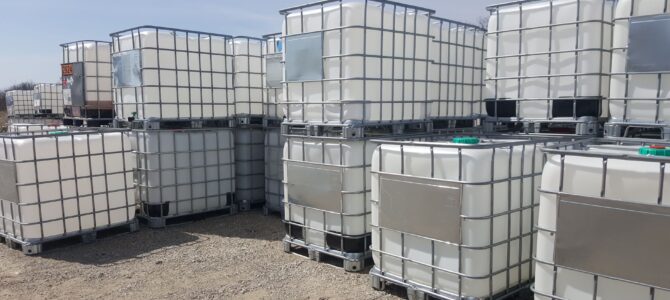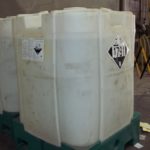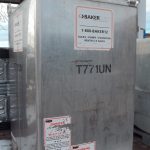The Pipeline and Hazardous Materials Safety Administration within the U.S. Department of Transportation (USDOT/PHMSA) regulates the transportation in commerce of hazardous materials to, from, or through the U.S. In its Hazardous Materials Regulations (HMR) it defines and authorizes the use of a variety of packagings for the transportation of hazardous materials (HazMat). Just one of those packagings is the intermediate bulk container (IBC).
Intermediate bulk container (IBC) is defined at 49 CFR 171.8:
Intermediate bulk container or IBC means a rigid or flexible portable packaging, other than a cylinder or portable tank, which is designed for mechanical handling. Standards for IBCs manufactured in the United States are set forth in subparts N and O of part 178 of this subchapter.
- Flexible IBC
- Rigid plastic IBC
- Composite IBC
- Metal IBC
|
Daniels Training Services, Inc. 815.821.1550 |
So let’s break it down…
- An IBC may be either rigid or flexible. So, it may be self-supporting (maybe stackable) or it might be similar to a plastic bag that is only provided structure by the HazMat it contains.
- It must be portable, which makes sense if you’re going to offer it for transportation.
- It cannot be a cylinder (for compressed gases) or a portable tank. Here, as elsewhere when defining HazMat packaging, at least part of the packagings definition is based on what it is not.
- It must be designed for mechanical handling. Though imprecise, I believe this is the key to the definition of an IBC. In this language USDOT/PHMSA indicates that whatever its appearance, the IBC is not designed to be moved by a person (as may be a drum, box, or jerrican). Instead, an IBC will have hooks, straps, be palletized, or have some other feature that allows it to be moved by equipment such as a fork truck or crane.
And…
- An IBC manufactured in the U.S. must be made according to the performance-oriented standards in 49 CFR 178, subpart N and be tested per the requirements of 49 CFR 178, subpart O.
- And that’s it!
|
Interested in a Webinar that covers this topic, and more! |
Notice anything strange?
The definition does not require an IBC to be a bulk packaging, i.e., have a capacity of more than 450 L (119 gal) even though the name includes the word “bulk”. Neither does the definition specify a minimum or maximum capacity as it does for the large packaging. Therefore, if it complies with the remainder of the definition, an IBC could have a capacity of no more than 1.3 L (5 gal), or less!
Where else is IBC mentioned?
- Intermediate bulk container (IBC) is included in the definitions for the following in 49 CFR 171.8.
- The definition of cargo tank specifies that it – the cargo tank – is not an IBC.
- The definition of a UN portable tank specifies that an IBC may not be a UN portable tank.
- 49 CFR 173.35 is a section of the HMR dedicated just to the filling and offering for transport of HazMat in IBCs.
- IBC is identified as an authorized packaging for a variety of HazMat in 49 CFR 173.
- There are special requirements and options for the display of hazard communication on IBCs in part 172 of the HMR.
Conclusion:
As you can see, the definition of an IBC is both simple and vague. Nowhere, not even in subparts N and O of part 178, does it mandate an appearance or specify a shape or design for the finished packaging. This presents both an opportunity and a challenge:
- As an opportunity it allows the shipper to construct an IBC of any shape, size, or capacity to contain its HazMat.
- A challenge in that sometimes you may not know if a packaging is an IBC unless it displays one of the packaging type codes designating it as an IBC:
- 11 for a rigid IBC that discharges solids by gravity.
- 13 for a flexible IBC that discharges solids by gravity.
- 21 for a rigid IBC that discharges solids under pressure of more than 10 kPa (1.45 psig).
- 31 for a rigid IBC designed for liquids.
|
If you like this article, please share it using any of the social media platforms identified at the bottom of this article. |




